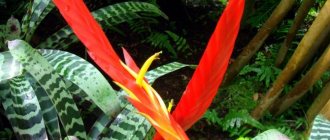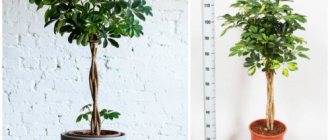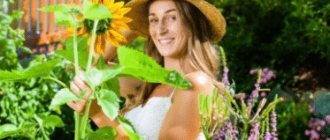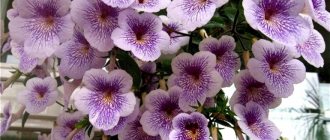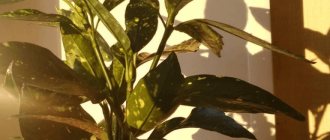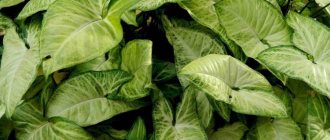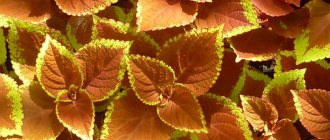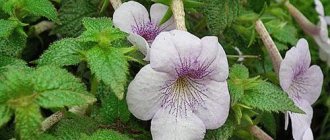Vriesia was isolated from the Tillandsia genus, which in turn has more than 250 species. Another name that is also often used by gardeners is frisia.
In the wild, the flower grows in the tropics and subtropics of America. Flowers live on the bark of trees and in gorges. Wild representatives feel great even on the highest rocks.
Vriesia in the wild
What does it look like
The leaf rosette of Vriesea Splenriet looks like a funnel consisting of long, hard leaves. Leaf blades may be green or striped. The peduncle grows from the very center of the funnel and is decorated with a spike-shaped inflorescence. The bracts fit tightly together and are colored in a wide variety of shades. Depending on the varietal variety, the stem can be single or branched.
Vriesia flower
Description and photo of the flower
Vriesea splenrieta is a stemless houseplant native to sunny South America. The plant belongs to the Bromeliad family. They gained popularity for the most part due to their spectacular appearance: unique feather-shaped inflorescences with exotic-looking bracts.
The Vriesia splenrieta bush is an unusually shaped shrub with long and wide leaves, which are colored with uneven stripes of light green and dark green. At the base, the leaves form a cavity, the volume of which can reach 5-6 liters.
The peduncle is oblong, grows in the shape of a spike and reaches a height of more than 1 meter. The inflorescence with bracts can have a very diverse color: green, orange, scarlet and yellow, milky shades.
For its unusual shape of inflorescences, Vriesia splenrieta is popularly called “fiery sword”. The fruits appear in the form of a miniature capsule richly filled with seeds.
Vriesia splenrieta is an exotic flower, caring for and growing it is not easy, but fascinating. Having understood the rules for caring for this representative of the Bromiliaceae, the gardener will be able to fully enjoy the flowering of such a colorful plant.
To create conditions that are comfortable for growing, you should focus on the flower’s natural habitat. To plant Vriesia splenrieta, it is necessary to select nutritious and loose soil based on peat, pine bark, sand component, rotted leaves, turf soil, sphagnum moss and charcoal. It is imperative to ensure proper drainage and air circulation for the plant’s root system.
How to choose a vriesia when purchasing?
It is best to purchase vriesia when the inflorescence has barely formed, but has not yet colored, since a plant with an already blossoming bud will not live long, and you may not get children from such a specimen. They begin to form a little earlier - before the bud appears.
Vriesia: growing and care at home
For the vriesia flower, care at home consists of a large number of necessary measures. The decorative appearance of the plant and unusual flowering are possible if the rules of cultivation and care are followed.
Temperature
Vriesia - home care, how Vriesia blooms
Vriesia Splenriet is very particular about the temperature regime. The plant is thermophilic. A climate with a constant temperature of at least +18 degrees suits it best.
Important! The plant will not survive in open ground; it does not tolerate even the slightest temperature changes.
Lighting
In winter, it is best to place the plant in the most illuminated place. In summer, the pot should be moved to partial shade to prevent burns.
Watering
The culture loves moisture, prefers settled warm water. In the cold season, the Vriesia flower is watered only once a week, in the summer - 2 times. The plant loves it when watering is done not only into the ground, but also directly into the leaf funnels. Full sprinkling is best done in the summer.
Spraying
It is important to keep the plant in constantly moist conditions. This is achieved by spraying. It is advisable to do it several times a day. It is necessary to irrigate the entire flower and soil.
Humidity
The plant is native to the tropics. It is very important to maintain the required level of soil moisture for the flower at home. A good way is to place the plant on a special tray filled with drainage and water.
Priming
The substrate for the plant should be as light and loose as possible. To prepare you need to mix:
- garden soil - 2 parts;
- turf soil – 1 part;
- sifted sand - 1 part;
- pine bark - 1 part.
Important! Pine bark requires mandatory processing before use. It can be baked in the oven or covered with steam. This will disinfect the bark and rid it of harmful insects.
Adding sphagnum or charcoal to the mixture will promptly rid the plant of excess moisture. If you don’t want to prepare the soil yourself, you can purchase it at a specialized store.
Feeding
Caring for vriesia involves applying liquid fertilizers throughout the spring and autumn. Feeding is carried out once every 14 days. In this species, nutrients are applied directly to the outlet, since the root system does not affect the proper development of the flower.
Description of Vriesia
Vriesia is one of the most decorative representatives of the large bromeliad family. Perennial. Refers to epiphytic (growing or permanently attached to other plants) herbaceous plants. Vriesia is native to the tropical forests of South and Central America, including southern Argentina and Brazil. The plant is also widespread in the West Indies.
In 1843, the genus Vriesia was isolated from the genus Tillandsia by botanist John Lindley. The plant was named after the famous Dutch botanist and physician Willem Henrik de Vries (Vries).
The leaves of the plant reach a length of 20 cm and have a curved appearance with smooth edges collected in rosettes. The color of the leaves can be of various shades: from light green to emerald. In addition, the leaves can be decorated with alternating multi-colored stripes, reminiscent of a sailor's vest. The dense girth of the leaves forms a “natural funnel” for the accumulation of rainwater. Some plant varieties are able to accumulate up to 5 liters. The funnel also serves as a habitat for many insects and bacteria.
The peduncle is long, sometimes reaching up to 1 meter. Spike-shaped multi-flowered inflorescences with bracts of various colors are formed on it. They can be monochromatic - red, yellow or multi-colored - red-orange, yellow-red. The bracts last a long time - several months, the flowers fade very quickly. The fruit is a capsule containing seeds with tuft-shaped appendages.
During flowering, Vriesia amazes with its beauty even the most distant and indifferent people from floriculture. Her bright “feather” creates a real sensation and an extraordinary spectacle. Spike-shaped flowers of orange, red, yellow and purple colors are located on a peduncle that can reach a length of 1 meter. Unfortunately, the flower itself fades very quickly, but the bracts delight with their beauty for several months.
The roots of the flower are bulky and weak. They have practically lost the function of absorbing nutrients and serve to attach and retain Vriesia on the substrate. Vriesia receives the necessary nutrition and moisture from the leaf funnel.
Under natural conditions, the plant grows in tropical rainforests at an altitude of 2500 m above sea level. With the help of roots, it attaches to the bark of trees (it does not feed on tree sap), snags, and rocks. In southeastern Brazil, the cliffs are covered with a carpet of various species of Vriesia and Tillandsia.
There are about 250 species of both epiphytic and terrestrial plants. About 100 species are used for home keeping. This exotic flower is known in the circles of exotic connoisseurs for some sensitivity and fastidiousness. It is considered the most heat-loving of all bromeliads, and before purchasing one, consider whether you can provide it with suitable conditions.
Vriesia Splenriet (Brilliant), the most common variety for growing indoors. The large leaves reach sixty centimeters in width and have dark brown stripes, which gave this plant another name: “Tiger Vriesia”. The peduncle is deep red, up to eighty centimeters high and contains yellowish flowers.
The flower Vriesea splenrieta (otherwise known as shiny) is adapted for growing at home and is a herbaceous perennial with spotted green leaves. The rosette of the flower, also called “fire sword” and “tiger bromeliad” because of its coloring, is quite wide. The spike-shaped inflorescence is located on a bright red peduncle and reaches a height of about 80 cm. The flowers are yellow, surrounded by bracts of bright red leaves.
Transfer
Dipladenia (Mandevilla) - growing and care at home
Transplanting an indoor vriesea flower should be carried out only in the most extreme cases. The plant reacts painfully to this process. Transplantation is possible only if the pot has become small. Even with the slightest damage to the roots, the flower will take a long time to recover, and may even die.
Attention! It is forbidden to deepen the flower rosette - this may cause rotting of the base.
Why doesn't Vriesia bloom?
Often Vriesea "Splenriet" does not form inflorescences. How can you stimulate bud production? A small concentration of ethylene must be used. The plant produces organic matter independently.
Ethylene promotes the formation of buds.
You can add ethylene artificially. Ethylene can be extracted from ripening fruits. It is enough to take a bunch of bananas and wrap them in a plastic bag along with the crop for several hours.
How does it reproduce
There are two options for propagating the Vriesea Splenriet flower: seeds and suckers.
Vriesia keeled from seeds
This is a complex and extremely thankless method of reproduction. To collect seeds from a flower, you must wait until the peduncle has fully matured. Sowing is carried out in a mixture of river sand and sphagnum. To improve germination, seed material is pre-treated with potassium permanganate and dried.
Flower seed shoots
Watering is best done using a spray bottle. The container with plantings is covered with glass and constantly ventilated. The first shoots will appear only in a month. The young plant picks up after the first true leaves appear. The substrate for it should consist of peat, leaf and turf soil. After six months, the vriesia is transplanted into a larger container. Flowering of an ornamental plant grown from seeds will begin no earlier than after 5 years.
Vegetative propagation
Replanting Vriesia after flowering is done after it has completely faded. Young shoots form in place of the flower. When the “kids” grow enough, they need to be separated from the “parent” and planted in another pot.
Plant propagation by children
The substrate is prepared from 3 parts of leaf soil, 1 part of sifted sand, 1 part of pine bark. During rooting, the young flower of Vriesia Splenriet is covered with a film or bag. The rooting process occurs within approximately 30 days. Only after this can the plant be transplanted to a permanent place of residence.
On a note! Flowering will begin only 4 years after transplantation.
Air and soil humidity
It is best to maintain humidity at 70-75%, while avoiding excessive drying of the top layer of soil or, conversely, watering beyond normal.
Water procedures should be carried out twice a month. Immerse the vriesea splenrieta flower completely in soft water at room temperature and let it saturate and absorb plenty of moisture.
You can irrigate the leaves with previously settled water, and fill the tray with moisture-intensive components - pieces of moss, pebbles.
To maintain the microclimate next to the flower, place a container of water and install a humidifier, and in winter, take care to place the plant away from heating elements.
It is worth watering directly into the outlet, keeping it clean, because getting soil inside harms the plant.
Possible problems
If watering rules are not followed, the plant may become infected with fungal diseases. Most often it is gray rot or fusarium. For urgent treatment, it is necessary to adjust the watering regime - reduce it. Then the freesia needs to be treated with a fungicide.
Insufficient humidity in the room will immediately affect the plant. The ends of the leaves will immediately begin to dry out. Treatment is to increase the humidity level in the room.
Why doesn't Vriesia bloom?
The main reason for the lack of flowers is cold air. Flowering of Vriesia can be achieved artificially:
- The pot is covered with any transparent vessel.
- Fresh fruits are laid out near the plant.
Additional Information. The fruit contains ethylene, a substance that causes the flowering process.
Pests
There are a number of pests that can damage vriesea: spider mites, thrips, scale insects. These insects cause yellowing of the leaf blade and rotting of the roots. To protect the plant, it is necessary to urgently treat it with a soap solution and then spray it with fungicides. The scale insects that often live on the flower can only be removed by hand.
Important! When the first signs of a pest invasion appear, the plant must be isolated from other indoor flowers.
Pests and diseases
Diseases for Vriesia splenrieta, which was cared for properly, are not typical. However, if development conditions are violated, the following may occur:
- reduced air humidity, excessive watering - fading of leaves, delayed development and growth;
- burns from ultraviolet radiation - the appearance of pale and brown spots;
- hard water - the tips of the leaves turn black;
- lack of irrigation - leaves dry out and turn black;
- exposure to cold air - wilting, inflorescences fall off, leaves become thinner;
- excessive watering or improper cutting of children for planting - rotting and death of the flower;
- not enough light baths - faded and faded buds;
- fungal infection is observed with gray spots and is often associated with intensive watering of the plant.
Among the pests that can attack Vriesia splenrieta are: bromeliad, palm, comb and black scale insects, red spider mites, mealy bugs, bristle bugs and root bugs.
Common varieties
There are more than 250 species of Vriesia in the wild. There are significantly fewer indoor subspecies and they come in two types: with plain and with striped leaf plates.
With plain leaves
Many varieties of Vriesia are represented by monochromatic foliage in different shades. The inflorescences can also have different colors.
Royal
This is the largest representative of Vriesia Fenestralis. The leaves can reach 50 cm, and the peduncle – 2 meters. The inflorescences of this species resemble a panicle. In the early stages, the flowers are white, and after full maturity they are yellow. The royal variety has a very strong aroma.
Royal variety
Mix
This is the most interesting species, which has won a lot of fans thanks to its unusual appearance and variety of color palette of inflorescences. Its foliage is bright green, its flowers are oddly shaped with highly branched inflorescences in the middle. The color can be yellow, orange, red or cherry.
Vriesia Mix
With striped leaves
Striped leaves can have a longitudinal or transverse pattern. The flowers of these varieties are red, yellow, and orange.
Kinds
More than one hundred and fifty species of Vriesia are used in indoor floriculture. The most common among them are:
Brilliant is the homeland of Vriesia brilliantis in the rainforests of Guinea. Vriesia of this species is a perennial plant with dark, broadly lanceolate leaves covered with transverse brown spots and stripes, which are collected in a rosette. Peduncle, bracts are bright red, flowers are yellow. The plant attracts the eye with its bright color.
Vriesia splenrieta - fire sword is the name of this species. This is a plant with long leaves decorated with transverse yellow stripes, a long peduncle with a bright bract, and yellow flowers.
Keeled is the home of the forest of Eastern Brazil. The Vriesia flower is distinguished by shorter, unpatterned leaves, about twenty-five centimeters long. The inflorescence is erect or drooping, not multi-flowered. This species has unusually colored leaves. Red or bright pink with a yellow or bright green border along the edge and top, they are the main decoration of the flower, which is actually grown for these leaves.
Hieroglyphic - a beautiful vriesea with arched light green leaves decorated with transverse stripes and an inflorescence panicle. The flowers of Vriesia hieroglyphica are yellow, the bracts are red, yellow or green.
Giant is a plant native to the forests of Brazil and it is not for nothing that it is called giant. This kind of vriesia is rarely grown as an indoor crop. Its numerous, meter-long leaves form a large funnel with loose inflorescences in the center on a straight peduncle. Excellent for decorating office premises, winter gardens, and shop windows.
Reproduction, planting and replanting of Vriesia at home
Flower propagation is possible by seeds or offspring:
- The seed method is quite labor-intensive. There is a high probability that the plant will not retain its varietal characteristics, and will bloom only after 5 or more years. The seeds must be removed from the testes, washed in a weak solution of potassium permanganate (potassium permanganate), dried and sown in peat or sphagnum with coarse sand. Then create a mini-greenhouse using polyethylene or a jar. Keep at 22-26 °C, ventilate and spray every day. Shoots can be expected on the 10-20th day. After 2-3 months, the seedlings should be planted in the substrate.
- It is easier to propagate by cuttings when they have reached 1/3 of the height of the mother plant. Preferably in the spring. The shoots are carefully separated from the “parent” and the cut sites are treated with crushed coal (prevention of rotting). If the adult plant is still viable, then the container and soil are replaced. The children are seated in small pots with a suitable substrate and a mini-greenhouse is made at 26 °C, which is ventilated daily. After a month, greenhouse conditions can be canceled.
When planting on the bottom, you need to fill the drainage with a height of about 1/3 of the dish (expanded clay, shards of clay products, charcoal), fill the same volume with soil mixture, place the plants and sprinkle the substrate up to the root collar.
This plant really does not like transplanting. You can disturb him at least once every three years. Populating a bromeliad tree (or simply a snag) is a creative work that involves covering the roots of young bushes (with a formed rosette) with sphagnum moss and attaching each specimen to the base using wire, fishing line or nylon thread. Then the tree needs to be sprayed.
It will also be interesting: Aphelandra - caring for a houseplant at home?
Bloom
Vriesia blooms in late spring or summer. In this regard, much depends on the time of planting the flower and the conditions of its maintenance. First, a peduncle appears, then a bright orange spikelet forms on it. Vriesia's flowers themselves are small and inconspicuous. Flower growers love this plant precisely for the shape and color of the inflorescence. After flowering, the plant usually dies or is destroyed, but during this time the children have time to grow.
Tip: If the vriesea does not bloom, it is recommended to place an apple or banana next to it and cover the flower with a cap or polyethylene. The fact is that the flowering of Vriesia is promoted by ethylene gas, which is released when the fruits ripen. Sometimes Vriesia may not bloom due to the cool location during the period of plant activity.
Care after flowering
After the plant has flowered, it is necessary to remove the flower stalk if you do not plan to get seeds. Then, as the leaves die, they are also removed. During this period, Vriesia's children will actively grow. There is no need to pour water into the outlet. In about a year or two, the children will get stronger, and they will have their own root system. Then the mother plant is disposed of, and the children are planted in prepared soil.
Characteristics of care
The bulbous root system is capable of storing moisture in large quantities, and there is no need to use it for a certain period of time. Therefore, the pot must have holes to drain excess water.
For spraying, it is advisable to use water at room temperature.
Do not use plain tap water. It should sit well for two hours to break down the chlorine and suspended solids that cause hardness. For areas with high natural mineralization of water, use boiled water.
It is recommended to regularly spray lily leaves
During the flowering period, the plant is sprayed carefully so that water does not get on the eucharis flowers.
Once every two weeks, when watering the plant, use special organic and mineral fertilizers.
